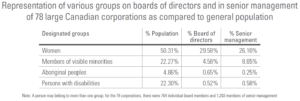The quest for diversity of boards of directors and in senior management of public corporations
François Dauphin, Yvan Allaire and Mantote Sambiani | IGOPPIn June 2009, IGOPP published a Policy Paper on “The Status of Women on Boards of Directors in Canada: Calling for Change”. Almost 12 years later, the issue of diversity on boards of directors still remains partly unresolved. Indeed, women’s representation on boards of directors has doubled during this period [from 15% in 2008 to 29.58% in 2020] but the target of 40% gender diversity set in the IGOPP Policy Paper has not yet been achieved.
But by now a broader definition of diversity is proposed, a definition which targets an adequate representation of several groups making up the general population of the society where an organization is domiciled.
Responding to this emerging trend, the government of Canada amended the Canada Business Corporations Act (CBCA) to foster an increased diversity on boards of directors as well as in the senior management of public corporations. These changes, which came into effect on January 1, 2020, aimed at increasing the representation of women but also of Aboriginal people, persons with disabilities and members of visible minorities. These new legal stipulations apply to federally incorporated corporations listed on a stock exchange. Thus 78 of Canada’s largest corporations, drawn from the S&P/TSX index were subjected to these new requirements.
The following table captures, in raw form, the source of disquiet about representation:

This report begins with a brief comparison of the Canadian law with that of other countries. Then we sketch an overview of the representation of designated groups on boards and senior management of the companies subjected to the new legal stipulations. We collected the information which these 78 companies disclosed in 2020 and compiled the above table. We then carried out further analyses factoring in educational variables and age.
Several observations emerge from this analysis; the most significant ones are as follows:
- Canada is at the forefront of this quest for diversity beyond the representation of women on boards of directors to include diversity in the senior management of companies, as well as the representation of Aboriginal peoples, persons with disabilities and persons belonging to visible minorities. The Canadian government has opted for a flexible approach, emphasizing disclosure, rather than a quota approach, as advocated in some other jurisdictions.
- The subject companies have interpreted very freely the regulation concerning the number of members of senior management who must be considered for disclosure. The definition in the regulations provides for 5 to 7 senior management members. However, the subject companies defined senior management as made up of some 16 members on average. More than half of the companies seem to have interpreted the regulation incorrectly (but that probably reflects their own internal definition of senior management).
- Although the gains made over the past decade are notable, much remains to be done in terms of the representation of women on boards of directors as well as in the senior management of companies.
- Taking into account the variables of age and education, although these two factors are not exhaustive of all factors influencing selection and promotion, we see a clear under-representation of members of visible minorities within the boards of directors
and senior management of publicly traded Canadian companies.
The rate of renewal of board members and senior management is rather slow. Some measures (for instance, quotas, tenure and/or age limit) would accelerate the turnover of board membership but these must be carefully assessed. Absent coercive measures, social systems change over relatively long periods of time.
The laudable goal of increasing the diversity of representation on corporate boards and in the senior management of large corporations will not be achieved without much management goodwill, as well as investors and government prodding, particularly so when that goal includes not only the representation of women but also that of various other groups making up a society.


